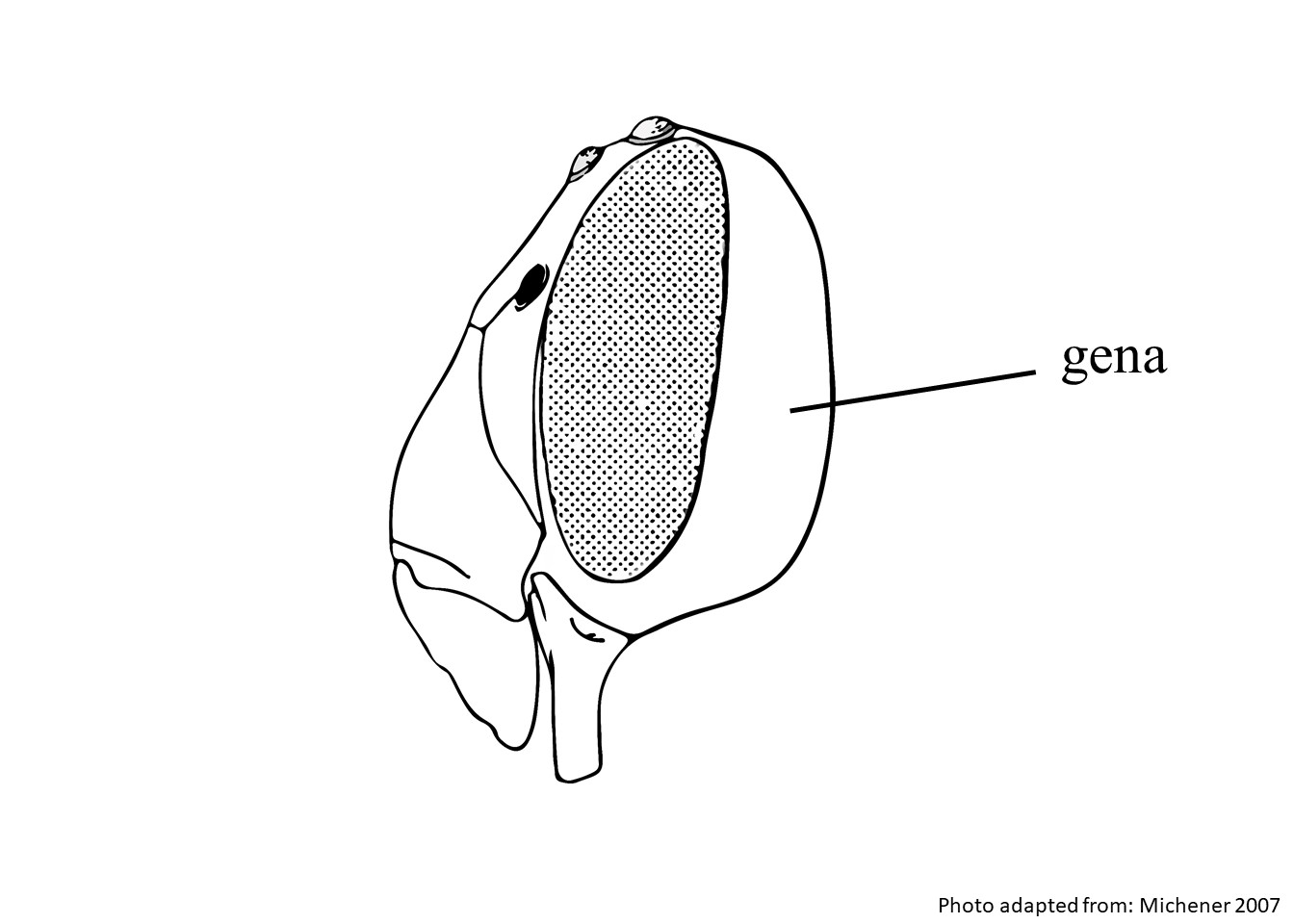Family: Megachilidae
Subfamily: Megachilinae
Tribe: Megachilini
Genus: Megachile Latreille, 1802
Subgenus: Rhyssomegachile Michener, 1965
Common name: none
Megachile (Rhyssomegachile) are medium-sized bees with overall black integumentintegument:
a tough, protective outer layer
, sometimes with reddish-brown coloration on the mandiblemandible:
bee teeth, so to speak, usually crossed and folded in front of the mouth, legs, tegulategula:
the usually oval, small shield-like structure carried at the extreme base of the wing where it attaches to the body, and sternasterna:
the plates on the underside of the abdomen, often abbreviated when referring to a specific segment to S1, S2, S3, S4, S5, S6, S7, or S8
 . They often have white apicalapical:
. They often have white apicalapical:
near or at the apex or end of any structure
hair bandsbands:
usually referring to bands of hair or bands of color that traverse across an abdominal segment
on the tergaterga:
the segments on the top side of the abdomen, often abbreviated when referring to a specific segment to T1, T2, T3, T4, T5, T6, or T7 and can range in body length from 8–12 mm (Gonzalez et al. 2018Gonzalez et al. 2018:
and can range in body length from 8–12 mm (Gonzalez et al. 2018Gonzalez et al. 2018:
Gonzalez, V.H., T. Griswold, and M.S. Engel. 2018. South American leaf-cutter bees (genus Megachile ) of the subgenera Rhyssomegachile and Zonomegachile , with two new subgenera (Hymenoptera: Megachilidae). Bulletin of the American Museum of Natural History 2018(425): 1-74.).
(modified from Gonzalez et al. 2018Gonzalez et al. 2018:
Gonzalez, V.H., T. Griswold, and M.S. Engel. 2018. South American leaf-cutter bees (genus Megachile ) of the subgenera Rhyssomegachile and Zonomegachile , with two new subgenera (Hymenoptera: Megachilidae). Bulletin of the American Museum of Natural History 2018(425): 1-74.)
 straight in profile.
straight in profile. with preapicalpreapical:
with preapicalpreapical:Megachile (Rhyssomegachile) may be confused with bees within the subgenera M. (Aporiochile), M. (Ptilosarus), and M. (Austromegachile) because they all have a strong preoccipital carinacarina:
a clearly defined ridge or keel, not necessarily high or acute; usually appears on bees as simply a raised line
behind the genagena:
the cheek or side of the head (Gonzalez et al. 2018Gonzalez et al. 2018:
(Gonzalez et al. 2018Gonzalez et al. 2018:
Gonzalez, V.H., T. Griswold, and M.S. Engel. 2018. South American leaf-cutter bees (genus Megachile ) of the subgenera Rhyssomegachile and Zonomegachile , with two new subgenera (Hymenoptera: Megachilidae). Bulletin of the American Museum of Natural History 2018(425): 1-74.). M. (Rhyssomegachile) females can be differentiated these other subgenera by the lack of white fasciae beneath the scopascopa:
modified hairs for carrying pollen; often branched and dense hairs on the hind-leg, or on the ventral surface of the abdomen in Megachilidae
and incomplete cutting edge on the third interspace. Further, males can be separated by the lack of a spine on the front coxacoxa:
the basal segment of the leg and the strong preapicalpreapical:
referring to a section of a bee that is physically found just before the outermost (or apical) end of the section or segment
carinacarina:
a clearly defined ridge or keel, not necessarily high or acute; usually appears on bees as simply a raised line
on T6T6:
the segments on the top side of the abdomen, often abbreviated when referring to a specific segment to T1, T2, T3, T4, T5, T6, or T7 (Michener 2007Michener 2007:
(Michener 2007Michener 2007:
Michener, C.D. 2007. The Bees of the World (2nd ed.). Johns Hopkins University Press, Baltimore and London, 953 pp.; Gonzalez et al. 2018Gonzalez et al. 2018:
Gonzalez, V.H., T. Griswold, and M.S. Engel. 2018. South American leaf-cutter bees (genus Megachile ) of the subgenera Rhyssomegachile and Zonomegachile , with two new subgenera (Hymenoptera: Megachilidae). Bulletin of the American Museum of Natural History 2018(425): 1-74.).
Floral associations are unknown.
Nesting behavior is unknown.
Megachile (Rhyssomegachile) consists of four species (Gonzalez et al. 2018Gonzalez et al. 2018:
Gonzalez, V.H., T. Griswold, and M.S. Engel. 2018. South American leaf-cutter bees (genus Megachile ) of the subgenera Rhyssomegachile and Zonomegachile , with two new subgenera (Hymenoptera: Megachilidae). Bulletin of the American Museum of Natural History 2018(425): 1-74.); none are known to occur in the U.S. or Canada.
There are no known invasives.
Megachile (Rhyssomegachile) are known only from South America and have been collected from Columbia to southern Brazil (Gonzalez et al. 2018Gonzalez et al. 2018:
Gonzalez, V.H., T. Griswold, and M.S. Engel. 2018. South American leaf-cutter bees (genus Megachile ) of the subgenera Rhyssomegachile and Zonomegachile , with two new subgenera (Hymenoptera: Megachilidae). Bulletin of the American Museum of Natural History 2018(425): 1-74.).

Distribution map generated by Discover Life -- click on map for details, credits, and terms of use.
Gonzalez, V.H., T.L. Griswold, M.S. Engel. 2018. South American leaf-cutter bees (genus Megachile) of the subgenera Rhyssomegachile and Zonomegachile, with two new subgenera (Hymenoptera: Megachilidae). Bulletin of the American Museum of Natural History 425: 1-74.
Michener, C.D. 2007. The Bees of the World (2nd ed.). Johns Hopkins University Press, Baltimore and London, 953 pp.